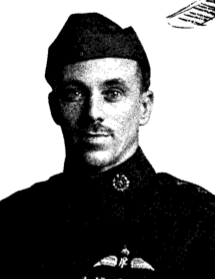
Douglas Campbell was an American aviator and World War I flying ace. He was the first American aviator flying in an American-trained air unit to achieve the status of ace.

Andrew Benoni Hammond was an American lumberman. He developed the Missoula Mercantile Co. He built the Bitterroot Valley Railroad and the Astoria & Columbia River Railroad. He was president of the Hammond Lumber Co. and the Hammond Steamship Co.

Francis Warrington Gillet was an American flying ace who served in both the American and British armed forces as a pilot during World War I. With 20 credited aerial victories he was the highest scoring pilot flying the Sopwith Dolphin, and the second highest scoring American, only surpassed by Eddie Rickenbacker.

Major David McKelvey Peterson was a 1915 Lehigh University graduate who became a World War I flying ace. He achieved six aerial victories, one of which was earned in the Lafayette Escadrille; five were officially credited during his tenure with the United States Army Air Service.

Frank O'Driscoll Hunter was a World War I flying ace, being credited by the United States Army Air Service with downing nine enemy aircraft. Hunter became an advocate of fighter aircraft strategy and tactics. In World War II he served as commanding general of the VIII Fighter Command and, later, the First Air Force.

Tenente Giorgio Pessi was a World War I flying ace born in Austria-Hungary who chose to fly for Italy. He was credited with six aerial victories.

Lieutenant William Thomas Ponder was an American World War I flying ace credited with six aerial victories.

Adjutant James Alexander Connelly Jr. was a World War I flying ace credited with seven aerial victories.
Jean Charles Romatet was a French military officer who served as a general in World War II. He began his career during World War I as a flying ace credited with seven aerial victories.

Lieutenant Clinton Leonard Jones, Jr. was an American World War I flying ace credited with eight aerial victories.
Squadron Leader Thomas Stanley Horry was a First World War flying ace credited with eight aerial victories.

Captain James William Pearson was an American World War I flying ace credited with twelve aerial victories while flying for the British Royal Air Force.
Major Adrien Louis Jacques Leps was a French World War I flying ace credited with twelve confirmed aerial victories, as well as two probables. He served originally in the cavalry, before shifting to flying. In later years, he served under General Armand Pinsard during World War II.
Adjutant Armond/Armand Jean Berthelot (1894–1961) was a French World War I flying ace credited with eleven confirmed aerial victories. He was a scourge to enemy aerial observers, as his victory record contained six observation aircraft and two observation balloons.
Adjutant Lucien Marcel Gasser (1897-1939) was a French flying ace during World War I. He was a double ace, credited with ten confirmed aerial victories.
Lieutenant Valentine St. Barbe Collins was a World War I British flying ace credited with ten aerial victories who served with the Royal Flying Corps and the Royal Air Force.
Lieutenant Melville Wells Waddington was a World War I Canadian flying ace credited with twelve aerial victories. He was the first observer ace in No. 20 Squadron of the Royal Flying Corps to score a victory in the Bristol Fighter.

Captain John Herbert Hedley was a World War I British flying ace credited with eleven aerial victories. The observer ace claimed to have survived a bizarre flying mishap which earned him the moniker "The Luckiest Man Alive." Hedley also survived uninjured after his plane was shot down in 1918, and he became a prisoner of war. After his immigration to the United States in 1920, he became a regular on the lecture circuit, enthralling American audiences with the stories of his military service.

Bogart Rogers was an American motion picture writer, producer, innovator, and a pursuit pilot and a flying ace in World War I with the Royal Air Force.

William Norman Reed was a World War II fighter pilot, first with the Flying Tigers, then with the Chinese-American Composite Wing, Fourteenth Air Force, United States Army Air Forces. He is credited with nine aerial victories, making him an ace.












